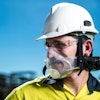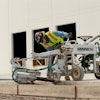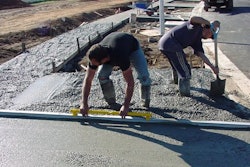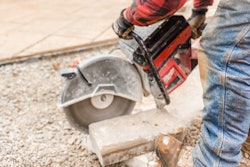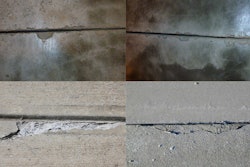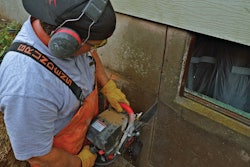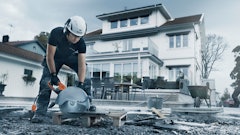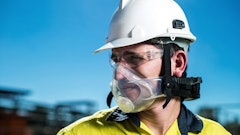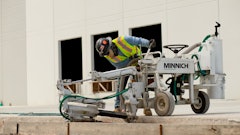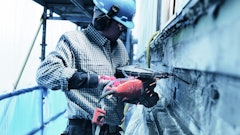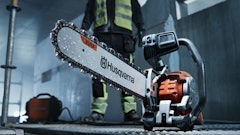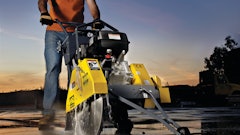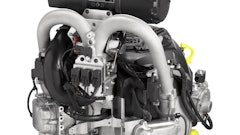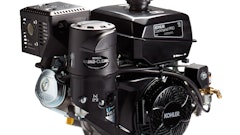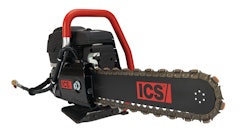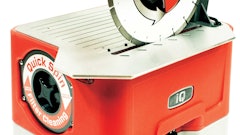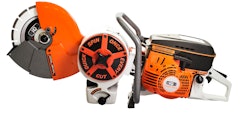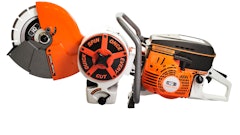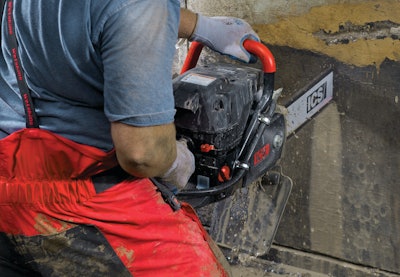
Cut-off machines and diamond chainsaws are the two most common concrete cutting tools, and their uses overlap quite a bit, but they are not interchangeable. By understanding the differences between these two types of equipment, you can make the right choice for your next job.
Cut-off machines — the industry standard
The go-to choice for most concrete cutting jobs, cut-off machines are hand-held saws used to cut concrete, asphalt and metal. They use either a composite resin abrasive wheel or diamond blade to cut in various construction applications. Typically available in 12- or 14-inch sizes, cut-off machines can be powered by a two-stroke gas engine, a hydraulic power unit, an air compressor or an electric motor.
The choice of power source depends on the application. According to Tom Carroll at CS Unitec, electric saws are popular with some operators because they're lightweight, less noisy and simpler to use than other types of cut-off machines. They aren't as powerful, however, and can take longer to complete a job.
"An electric cutter is preferred in enclosed environments," notes Kevin Axt at Hilti. "In cases like those, it's less about performance and more about what's needed in that particular situation."
Hydraulic saws, on the other hand, have the highest power to weight ratio. They're convenient because most contractors have a hydraulic power unit on hand, but they're more expensive and less forgiving than a pneumatic saw, for example.
"They can build up pressure in the hydraulic line," Carroll notes, which can result in difficult handling. "Also, a leak in a hydraulic line can be dangerous and expensive."
Pneumatic saws are also convenient, since air compressors are ubiquitous on jobsites. Operation is simple and has fewer potential hazards, Carroll says. "If the blade stalls, you just release the air pressure," he says, adding there's also no risk of fluid leaks. Pneumatic saws are lightweight and simple to maintain as well.
Axt at Hilti points out that pneumatic saws can be more expensive to use, however, due to the need for a compressor and the diesel fuel to power it.
Most popular among the various types of cut-off machines are gas-powered units. These tools offer the advantages of portability and familiarity, but they do require more maintenance.
Read next: Don't Let Dust and Slurry Get Saws Down
Besides power requirements and maintenance, there's also the question of weight versus performance. Operators appreciate a lighter saw because they're easier to use, but there is a trade-off. "It depends on what the operator really wants," says Axt. "If the saw is lighter, it will cut shallow with more passes, so it might take longer. A heavier saw, on the other hand, will cut deeper and faster but is heavier, which can make it harder to handle for some operators."
He continues, "For some, time is money. Others prefer to save wear and tear on the operator."
There are several things operators should be aware of when using a cut-off machine. "The end-user should read, understand and follow the directions and warnings in the instruction manual," says Steve Parmentier, manager of strategic accounts at Stihl Inc. He notes end-users should also have all the appropriate personal protective equipment as outlined in the instruction manual.
Diamond chainsaws meet a unique need
A diamond chainsaw is a tool designed like a wood-cutting chainsaw with a power head, guidebar and chain, which is driven by a sprocket from the power head around the guidebar, explains Bill Bray, vice president of sales and marketing at ICS, Blount Inc. As its name suggests, the chain on a diamond chainsaw incorporates diamond segments that are laser welded to the chain in place of the cutting teeth typical with a wood saw. The diamond segments, like on a traditional circular diamond blade, essentially create a grinding action that wears away the concrete, brick or other aggregate material. This grinding action creates a very safe cutting operation with none of the kickback that is associated with a wood chain.
Read next: Diamonds Are a Concrete Contractor’s Best Friend
Diamond chainsaws offer several advantages over the circular-blade cut-off machines, says Bray. "The chainsaw is designed to actually plunge nose first into the material and has the ability to cut more than twice as deep as a 14-inch circular blade. The smallest ICS gas saw allows a full 10-inch deep cut, and depending on the saw model, there are gas saws that can cut a full 16-inch depth," Bray says.
A gas saw with a 12-inch depth of cut is the most common on jobsites. There are hydraulic diamond chainsaws that can cut to a 25-inch depth. A 14-inch circular blade on a cut-off saw is designed for a maximum depth of slightly less than five inches.
"Because a diamond chainsaw uses a guidebar with a long narrow flat surface, the saw can provide a deeper cut with no overcut, allowing the operator to make square corners. This is not possible with a circular blade," Bray says. "Diamond chainsaws not only cut deeper with no overcuts but they can be used to make openings as small as 4 inches by 4 inches, the cutting depth of the bar. They are also useful in creating odd-shaped cuts in material."
When selecting a diamond chainsaw, the most important thing is to consider whether you need to cut openings deeper than five inches. "If the answer is yes, then a diamond chainsaw is the right tool," says Bray. "Most begin with a gas-driven two-cycle engine, as it offers portability and a lower initial investment." ICS recommends at least an 80cc engine which can use either a 12- or 14-inch cutting-depth guidebar.
If you have significant cutting needs, you might want to consider a hydraulic or pneumatic diamond chainsaw, which have more power and can utilize guidebars for openings up to 25 inches.
"There's a higher power to weight ratio with hydraulic and pneumatic diamond chainsaws," explains Carroll at CS Unitec. "If you're cutting hard concrete with steel reinforcement, you'll get much higher performance from pneumatic or hydraulic saws."
Silica dust control when cutting concrete
Whenever you are cutting concrete, you need to be concerned with dust control. In 2016, the Occupational Safety and Health Administration issued a final rule on silica dust exposure, which reduced the permissible exposure limit (PEL) of respirable crystalline silica on jobsites. The new limit is 50 micrograms per cubic meter of air over an 8-hours sift. The previous limit was 250 micrograms.
Read next: Breathe Safe When Cutting Concrete
Contractors cutting concrete are required to use engineering controls, such as water or ventilation, to limit worker exposure to silica dust. Respirators must be provided if engineering controls cannot adequately limit exposure.
When cutting concrete, wet cutting is recommended to help control dust. The water binds the dust and reduces the amount of airborne dust created while cutting the concrete. Another option is a dust collection system.
Ready next: Wetter is Better to Control Concrete Dust
Dust control methods should be used when cutting concrete not just because it is required by OSHA but because it keeps workers safe and healthy. As you're choosing the right saw for your concrete cutting job, make sure you are also putting dust control systems in place as well.
*This article was originally published in 2012 and updated in 2019.


